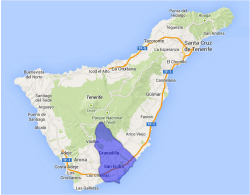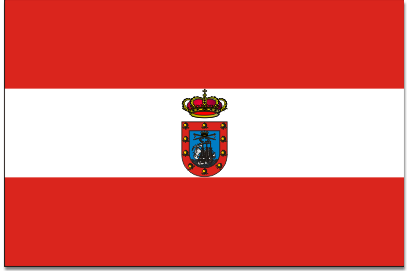
Area: 162.45 km².
Foundation: c. 1570 as a royal place, 1812 as a municipality and on November 17, 1908 as a town.
Population: 50,146 inhabitants (2019)
Locality: granadillero

Granadilla de Abona is located in the south of Tenerife (Canary Islands) and covers an area of 155 km2, making it the third largest municipality on the island. It stretches from the coast to the summit, crowned by the Guajara mountain at an altitude of 2,718 metres, the second highest peak in the archipelago, which overlooks the sea as one of the most emblematic natural elements of the island.
To the east, it borders the municipality of Arico along the deep and once plentiful El Río ravine. To the northwest, it borders the municipality of Vilaflor de Chasna and to the west with the municipality of San Miguel de Abona, separated from both by the deep ravine of La Orchilla. In more detail, from east to west, the municipality runs from the Barranco del Río, mentioned in 'Las Datas' of land distribution, as the river of Abona and the municipal boundary of Arico, since the municipalities were formed, to the Orchilla ravine in the west, which also forms the boundary with San Miguel de Abona; a ravine mentioned in the aforementioned datas as the river of Chasna (land therefore that of Granadilla, bathed between rivers). The landscape is fairly open and clear, with a more gentle slope than in other parts of the island, which is why these fertile plains have seemed suitable for cultivation since the first settlers arrived.
Together with Fasnia, Arico, Vilaflor, San Miguel and Arona, Granadilla forms the district of Chasna, an area that also included the ancient menceyato or aboriginal kingdom of Abona.

The name La Granadilla is not random or accidental, nor is it because there are more granadillos (Hypericum Canariensis - an endemic shrubby plant that can measure 2.5 metres) than in other parts of the island, because there has never been any record of this, nor is it precisely the best area of the island for its location. The most complex and concrete explanation would be the emulation of the small Granada, as the last Guanche stronghold (the uprising of Abona) and the continuation of the uprisings for decades, as is reflected in numerous minutes and agreements of the Cabildo. In this regard, mention should be made of the figure of Ichasagua, the leader of the uprising, who kept the colonists who wanted to settle in the southern area in check and who was even referred to in official texts as the lands of King Ichasagua.
Different elements, such as being to the southeast, overlooking the rising water in the same direction as Granada, the suitability of the green nature, its fountains and the fact that the scrubland reached there. For being in the middle of the toponyms that corresponded to the Duke of Medina Sidonia, and because it was his people who conquered Granadilla and Granada; for having the snow-capped mountains (Guajara) behind it, as in Granada; for having to fight the rebels as the last stronghold of resistance in the Canary Islands and the western Atlantic islands, as Granada was in the Reconquest of the Muslims, and because it was the centre and head of the menceyato of Abona, as Granada had been of the kingdom of the same name and the last stronghold of the infidels in the southeast of the whole Iberian Peninsula.

On 11 March 2010, the Canary Islands Council of Government awarded the Villa de Granadilla de Abona the status of 'Historic'. The award was based on its status as the last stronghold of resistance to the conquest of the Canary Islands and the fact that it hosted the visit of Ferdinand Magellan's fleet, as early as 1st October 1519, on his first voyage around the world.
This award is based on the favourable report issued on 20 January 2010 by the Heraldic Commission of the Autonomous Community of the Canary Islands, in which it states that there is sufficient merit to obtain this dignity. Several facts of great relevance stand out:
The condition of being the last stronghold of resistance to the conquest of the Canary Islands. Although the menceyatos of the south, including that of Abona, were classified as menceyatos of peace, due to their peaceful submission to the Castilians; the fighters of the upper area of what is now Granadilla were the protagonists of the last resistance.
They hosted the visit of Ferdinand Magellan's fleet, as early as 1st October 1519, on his first voyage around the world. On this voyage, Magellan and a large number of his sailors lost their lives. Only eighteen sailors, captained by Juan Sebastián Elcano, reached Spanish port alive. The epic that Ferdinand Magellan began as the proposer and leader of the expedition and which culminated in Juan Sebastian Elcano, after being elected leader by the survivors (once Magellan and his successors in command had died), in the middle of the voyage 'The First Round the World' (Circunsmundi), was the most important feat accomplished by modern man, up to that time, together with the discovery of America, and which had crucial consequences in the history of humanity.
Other merits of notorious importance: its 'hegemonic' role within the region of the south of Tenerife, during several centuries, highlighting its preponderant commercial importance during the XVII, XVIII and XIX centuries, and the fact of having the largest number of Assets of Cultural Interest of the whole region, which is an effective demonstration of its hegemony, and of its influence and importance in the History of the island of Tenerife.
The dossier has been processed in accordance with the procedure foreseen in the Order of 15 November 1990, which provides for the application of the procedures foreseen in Decree 123/1990, of 29 June, which regulates the procedure to be followed for the approval, by the Autonomous Community of the Canary Islands, of heraldic coats of arms, coats of arms, coats of arms, coats of arms, coats of arms and coats of arms of the Canary Islands, of heraldic coats of arms, coats of arms and flags of the islands and municipalities of the archipelago, to the proceedings being processed for the granting to local corporations of treatments, honours and distinctions, as well as for the granting to islands and municipalities of titles, mottos and dignities (BOC n. No. 147 of 26 November 1990). This title was granted following the request for the proposal made by the Department of Institutional Relations on 30 September 2008, which was brought to the plenary session and approved unanimously.


The flag of Granadilla de Abona is made up of three horizontal stripes of equal size, red, white and red. In the centre of the cloth, above the white stripe, the municipal coat of arms.Approval: Order of the Ministry of the Presidency and Institutional Relations of the Government of the Canary Islands of 3 January 1997.


Of azure, a 16th century ship of three masts, silver, bearing on the rear mast a grimpola with the inscription Victory, surmounted by a circle of ten stones in its colour, in turn surmounted by añepas in its colour set in a cross and an ancient one of gold. Border of gules with ten golden pomegranates. At the helm, a closed royal crown. In the coat of arms of Granadilla, the ship alludes to the fact that in 1525 the expedition of Ferdinand Magellan stopped in Puerto de Roja (today El Médano), which sailed around the world for the first time, and whose captain's ship was called Santa María de la Victoria. The circle of stones, the añepas and the ancient crown represent the Menceyato de Abona, one of the nine into which Tenerife was divided in pre-Hispanic times. The pomegranates of the border and their number represent the population centres that make up the municipality. Approval: Order of the Ministry of the Presidency and Tourism of the Government of the Canary Islands of 2 March 1995 (BOC of 17 March).








